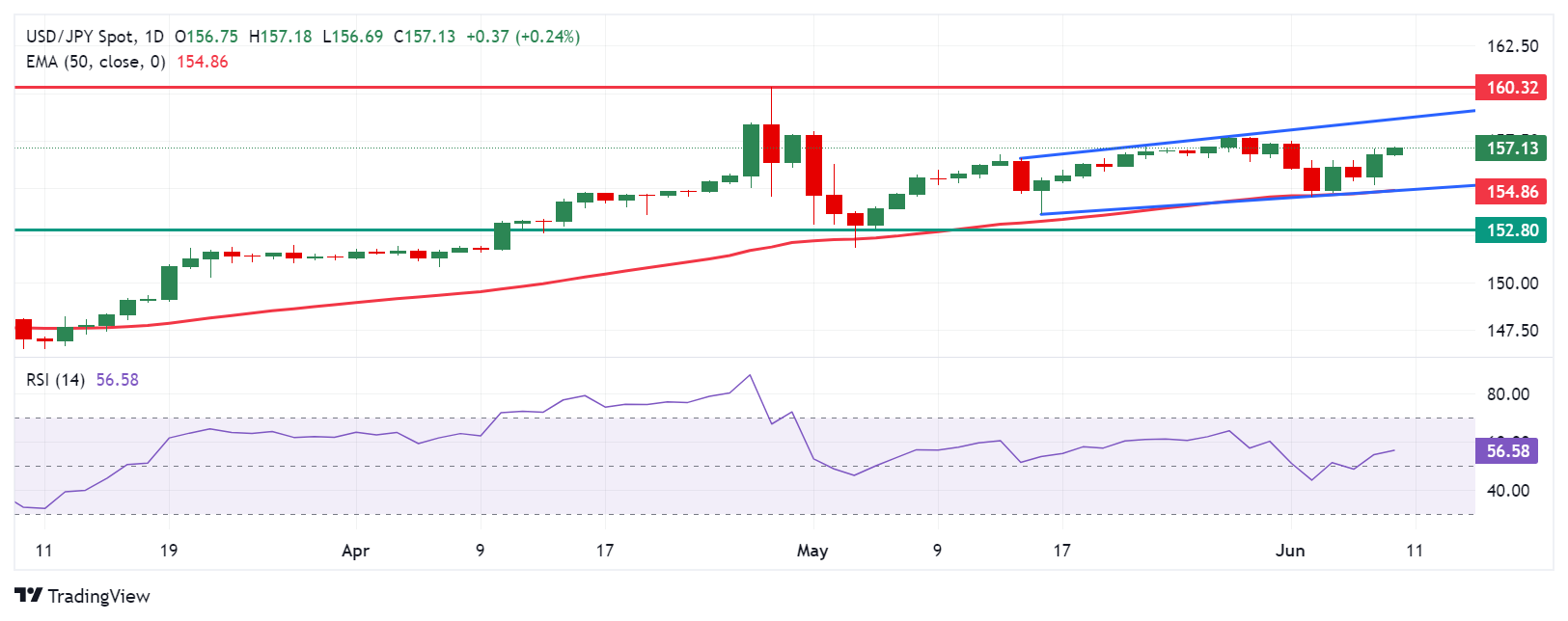Japanese Yen could limit downside as economy contracts less than expected in Q1

- The Japanese Yen lost ground as US Dollar advanced on robust jobs data.
- The mixed Japanese data may limit the downside of the JPY.
- Japan’s 10-year government bond yield moves above 1.01% ahead of the BoJ policy meeting on Friday.
The Japanese Yen (JPY) edges lower for the successive second trading day on Monday. The USD/JPY pair experienced support as the US Dollar (USD) regained its strength following the better-than-expected US employment data released on Friday.
Japan released mixed data on Monday, which could limit the downside of the Japanese Yen. Gross Domestic Product Annualized showed that Japan’s economy contracted less than expected in the first quarter. Meanwhile, GDP (QoQ) shrank in Q1, matching flash data.
The US Dollar Index (DXY), which measures the value of the US Dollar (USD) against six major currencies, continues to rise due to higher US Treasury yields. A strong US jobs report is expected to support a hawkish stance from the Federal Reserve. According to the CME FedWatch Tool, the probability of a Fed rate cut of at least 25 basis points in September has decreased to nearly 48.0%, down from 54.8% a week ago.
Daily Digest Market Movers: Japanese Yen declines after solid US labor data
- Japan’s Gross Domestic Product (GDP) Annualized contracted by 1.8% in the first quarter, compared to a previous decline of 2.0%. The figures slightly exceeded market forecasts of a 1.9% decrease. Meanwhile, Japan’s GDP (QoQ) shrank by 0.5%, in line with the flash data.
- Japan’s 10-year government bond yield moves above 1.01% ahead of the Bank of Japan’s (BoJ) policy meeting on Friday. The central bank is expected to maintain its current interest rates, while traders are closely watching for any potential reduction in the bank’s monthly bond purchases.
- Rabobank suggested in its report that the Federal Reserve may cut rates in September and December, more likely because of a deteriorating economy than because of progress on inflation. This is because they think that the US economy is entering a stagflationary phase with persistent inflation and an economic slowdown that is likely to end in a mild recession later this year.
- According to the US Bureau of Labor Statistics (BLS) on Friday, May’s US Nonfarm Payrolls (NFP) increased by 272,000, up from 165,000 in April. The wage inflation, as measured by the Average Hourly Earnings, rose 4.1% YoY in May from 4.0% (revised from 3.9%) in April, above the market consensus of 3.9%.
- Japanese Finance Minister Shunichi Suzuki stated on Friday that he will take action against excessive currency volatility when necessary and will assess the effectiveness of intervention. Suzuki emphasized the importance of maintaining market trust in public finances, mentioning that there is no fund limit for FX intervention, according to Reuters.
- Japanese Foreign Reserves released by the Ministry of Finance for May, dropped significantly to $1,231 billion in May from $1,279 billion. This has marked the lowest level since February 2023, as the government conducted foreign exchange intervention operations to defend the JPY.
- According to Reuters, while speaking to parliament on Thursday, Bank of Japan (BoJ) Governor Kazuo Ueda stated that inflation expectations are gradually rising but have yet to reach 2%. Ueda said, “We are still scrutinizing market developments since the March decision. As we proceed in exiting our massive monetary stimulus, it’s appropriate to reduce bond purchases.”
Technical Analysis: USD/JPY hovers around 157.00
USD/JPY trades around 157.10 on Monday. Analysis of the daily chart indicates a bullish bias as the pair consolidates within a rising channel pattern. Furthermore, the 14-day Relative Strength Index (RSI) is positioned above the 50 level, suggesting a tendency toward upward movement.
A key barrier is evident at the psychological level of 158.00. A breakthrough above this level could exert support to lead the USD/JPY pair to navigate the area around the upper boundary nearing the level of 158.60. The further resistance appears at the level of 160.32, its highest level in over thirty years.
On the downside, the lower threshold of the rising channel around the level of 154.90 appears as the key support, aligned with the 50-day Exponential Moving Average (EMA) of 154.86. A break below this level could increase pressure on the USD/JPY pair, potentially leading it toward the throwback support region around 152.80.
USD/JPY: Daily Chart
Japanese Yen price today
The table below shows the percentage change of the Japanese Yen (JPY) against listed major currencies today. Japanese Yen was the weakest against the Australian Dollar.
| USD | EUR | GBP | CAD | AUD | JPY | NZD | CHF | |
| USD | 0.12% | 0.07% | 0.05% | -0.10% | 0.18% | -0.02% | 0.17% | |
| EUR | -0.10% | -0.05% | -0.07% | -0.21% | 0.08% | -0.13% | 0.06% | |
| GBP | -0.08% | 0.05% | -0.03% | -0.17% | 0.11% | -0.10% | 0.10% | |
| CAD | -0.05% | 0.07% | 0.02% | -0.14% | 0.16% | -0.05% | 0.11% | |
| AUD | 0.12% | 0.24% | 0.18% | 0.14% | 0.28% | 0.08% | 0.26% | |
| JPY | -0.20% | -0.06% | -0.12% | -0.15% | -0.31% | -0.23% | -0.01% | |
| NZD | 0.02% | 0.13% | 0.08% | 0.05% | -0.09% | 0.21% | 0.17% | |
| CHF | -0.17% | -0.05% | -0.09% | -0.11% | -0.26% | 0.03% | -0.18% |
The heat map shows percentage changes of major currencies against each other. The base currency is picked from the left column, while the quote currency is picked from the top row. For example, if you pick the Euro from the left column and move along the horizontal line to the Japanese Yen, the percentage change displayed in the box will represent EUR (base)/JPY (quote).
